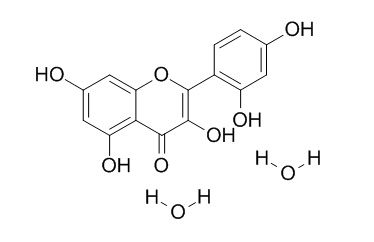Providing storage is as stated on the product vial and the vial is kept tightly sealed, the product can be stored for up to
24 months(2-8C).
Wherever possible, you should prepare and use solutions on the same day. However, if you need to make up stock solutions in advance, we recommend that you store the solution as aliquots in tightly sealed vials at -20C. Generally, these will be useable for up to two weeks. Before use, and prior to opening the vial we recommend that you allow your product to equilibrate to room temperature for at least 1 hour.
Need more advice on solubility, usage and handling? Please email to: service@chemfaces.com
The packaging of the product may have turned upside down during transportation, resulting in the natural compounds adhering to the neck or cap of the vial. take the vial out of its packaging and gently shake to let the compounds fall to the bottom of the vial. for liquid products, centrifuge at 200-500 RPM to gather the liquid at the bottom of the vial. try to avoid loss or contamination during handling.
Pharmacol Res. 2015 Oct;100:64-72.
3-Hydroxyflavone and structural analogues differentially activate pregnane X receptor: Implication for inflammatory bowel disease.[Pubmed:
26238175 ]
Pregnane X receptor (PXR; NR1I2) is a member of the superfamily of nuclear receptors that regulates the expression of genes involved in various biological processes, including drug transport and biotransformation.
METHODS AND RESULTS:
In the present study, we investigated the effect of 3-hydroxyflavone and its structurally-related analogues on PXR activity. 3-Hydroxyflavone, galangin, kaempferol, querceetin, isorhamnetin, and tamarixetin, but not but not datiscetin, morin, myricetin, or syringetin, activated mouse PXR, as assessed in a cell-based reporter gene assay. By comparison, 3-hydroxyflavone activated rat PXR, whereas 3-hydroxyflavone, galangin, quercetin, isorhamnetin, and tamarixetin activated human PXR (hPXR). A time-resolved fluorescence resonance energy transfer competitive ligand-binding assay showed binding to the ligand-binding domain of hPXR by 3-hydroxyflavone, galangin, quercetin, isorhamnetin, and tamarixetin. 3-Hydroxyflavone and galangin, but not quercetin, isorhamnetin, or tamarixetin, recruited steroid receptor coactivator (SRC)-1, SRC-2, and SRC-3 to hPXR. In LS180 human colon adenocarcinoma cells, 3-hydroxyflavone, quercetin, and tamarixetin increased CYP3A4, CYP3A5, and ABCB1 mRNA expression, whereas galangin and isorhamnetin increased CYP3A4 and ABCB1 but not CYP3A5 mRNA expression. Datiscetin, kaempferol, morin, myricetin, and syringetin did not attenuate the extent of hPXR activation by rifampicin, suggesting they are not hPXR antagonists.
CONCLUSIONS:
Overall, flavonols activate PXR in an analogue-specific and species-dependent manner. Substitution at the C2' or C5' position of 3-hydroxyflavone with a hydroxyl or methoxy group rendered it incapable of activating hPXR. Understanding the structure-activity relationship of flavonols in hPXR activation may facilitate nutraceutical development efforts in the treatment of PXR-associated intestinal diseases, such as inflammatory bowel disease.



